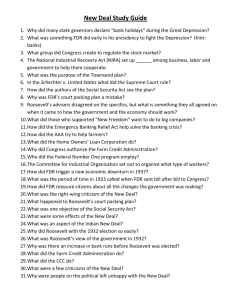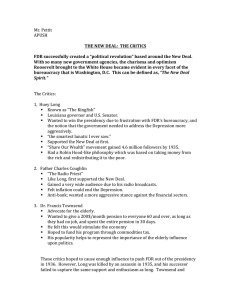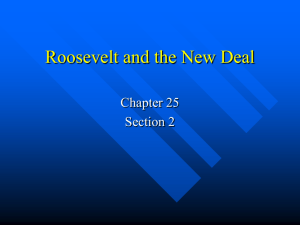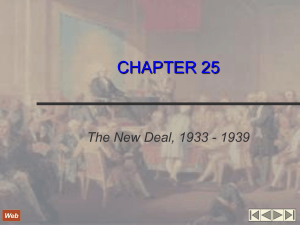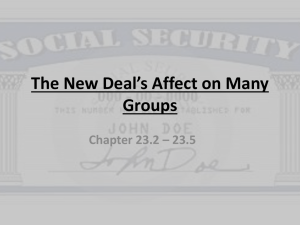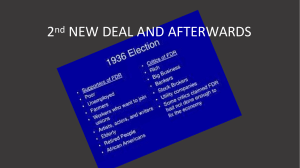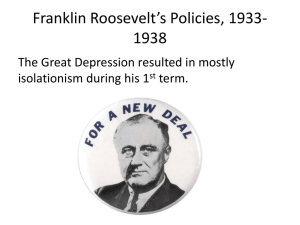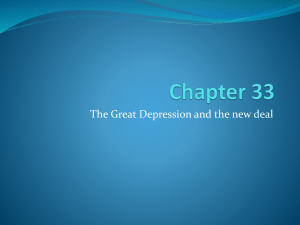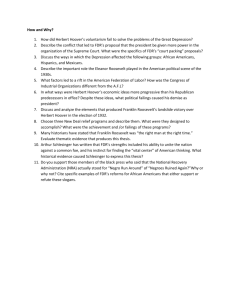chapt. 26
advertisement
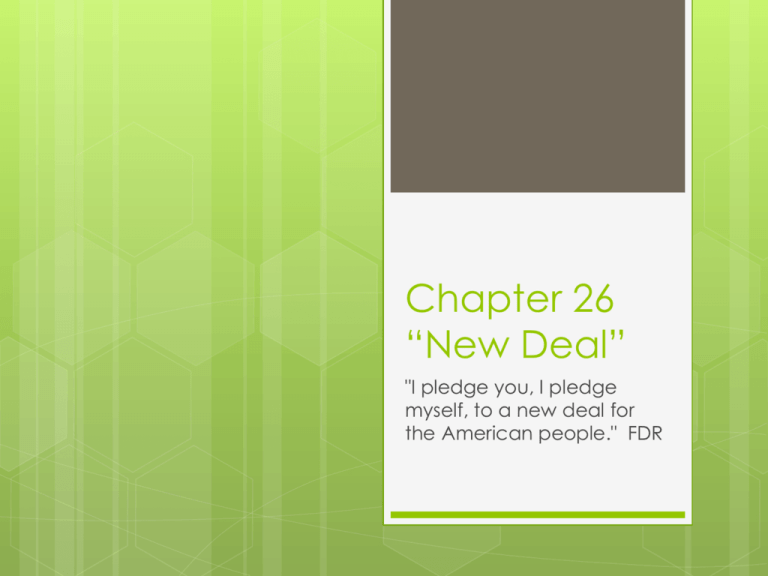
Chapter 26 “New Deal” "I pledge you, I pledge myself, to a new deal for the American people." FDR Launching Brain Trust Corporate greed, Republican mismanagement and failed purchasing power Relief- direct relief to people (unemployment) Recovery- of the economy Reform-legislation to change US Emergency Banking Act-federal assistance to banks Glass-steagall banking actrestricted speculation by banks and created FDIC Unemployment- CWA, CCC, TVA Industrial Recovery-NIRA to PWA and NRA (struck down in Schecter Poultry v. US exceeded Federal power) Should Federal power have right to regulate commerce? Did executive branch take over legislative? AAA store surplus –rise in prices Benefits distributed only to landowners, land for tenants usually cut out Voided by supreme court-replaced by SC and DAA act Broke despair, never achieved economic recovery 2nd New Deal Democrats increased their majorities in Congress. progress failed to keep pace with public expectations. Huey Long, Charles Coughlin, and Dr. Francis Townsend push Roosevelt farther to the left in 1935. greater regulation long-term relief The Social Security Act institutionalized a welfare state with a social insurance program for the aged, infirm, and dependent children. The National Labor Relations Act gave a powerful boost to organized labor. Legislation also strengthened federal control over the private sector. Roosevelt's 1936 reelection was built on a powerful coalition of the traditionally Democratic South, big city ethnics, and labor, and it reflected the wide impact of the New Deal on the American people. Impact Changed lives of all Americans (REA) Irrigation Electricity Boulder dam completed Limitations African Americans Marian Anderson-Af.Am. Singer Mary Bethune-Black Cabinet, National Youth Admin. FDR refused to sign anti-lynching laws- fear of southern dem votes Discrimination in New Deal programs Race riots Loose jobs to whites Lower wages Segregation Closed entirely to blacks To fix- quota system Indian Rights 1924 Native Americans given full citizenship Strengthened land claims Govt. could not take lands that were set aside for Native Americans Power to manage internal affairs revolving credit program for tribal land purchases, for educational assistance, and for aiding tribal organization. Diversion between tribal groups- good for functioning communal tribes bad if valued individualism, suspicion of govt. programs Women New deal agencies build female forcesocial workers, teachers etc. Frances Perkins- Labor Secretary for FDR Eleanor Roosevelt Campaign for Roosevelt Focus on aiding and protecting women not necessarily on employing them. Rise of Organized Labor AFL bound to skilled labor and organized on craft or skill- form CIO- unskilled labor Labor unions increase numbers Industry wide- mass production (Autos, rubber, electrical workers) Sit –down GM Memorial Day Massacre- Republican Steel Plant, 1937 Chicago Clash with police 10 workers killed End of New Deal ended in 1936 Court-packing bill angered the public and bolstered a conservative coalition of Republicans and rural Democrats. FDR's effort to balance the budget in 1937 led to a deep recession, and his vindictive attempt to unseat opponents failed. -----------------------------------------------------------------What did the New Deal do? created mechanisms to compensate for future swings in the economy modernized the presidency established a limited welfare state added new groups into the fold of democracy through "broker" politics transformed the Democratic party into a dominant force in American politics.

